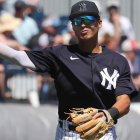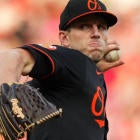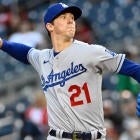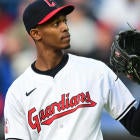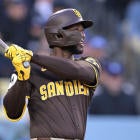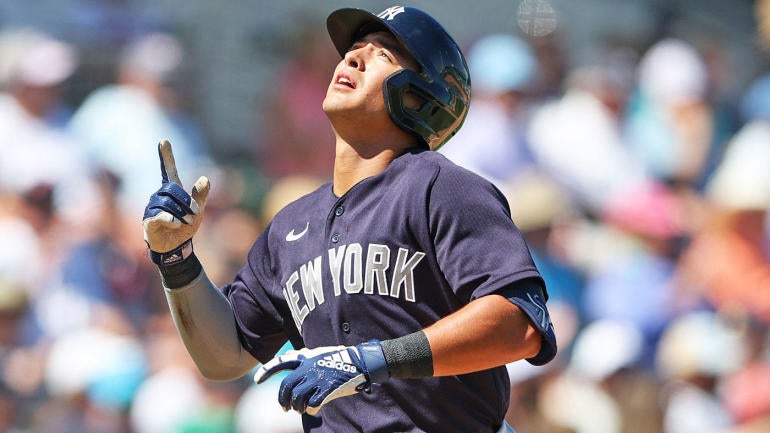
Fantasy Baseball rankings are never static. They're constantly changing thanks to new information, new perspectives, or just new opinions. I'm constantly doing research and talking about players, and sometimes I change my opinion about those players as a result.
That'll happen a lot during spring training especially. Injury timetables and playing time questions become more clear, players display new skills, and guys you overlooked for various reasons give you new reasons to look into them. Some players won't benefit from that attention, but since spring is a time for optimism, I'm going to focus today on the players I've moved up in my rankings since the start of spring training.
I won't necessarily have all 12 of these players on all of my remaining teams, but I'm a lot more likely to draft them than I was just a few weeks ago. Here's why:
Rankings risers
Anthony Volpe
At the start of spring training, Volpe seemed like a long shot to make the Yankees roster. He had a good season in the minors, but struggled at first at both Double-A and Triple-A, and it's never been clear if shortstop is his ideal long-term defensive home. However, they gave him a real chance to earn a job, and Volpe took that opportunity and ran with it, earning a spot on the Opening Day roster. It's worth taking Volpe's gaudy spring numbers with a bit of a grain of salt, of course – per Baseball-Reference.com's data, Volpe's average quality of opposing pitcher has been somewhere around a Double-A pitcher – but he's done everything you could have hoped for, including eight walks to 11 strikeouts in his first 14 games. He's also stolen five bases without being caught, adding an element of athleticism that the Yankees clearly craved going back to when they added Isiah Kiner-Falefa last offseason. Volpe may not be a prospect on the level of Corbin Carroll – he doesn't have the top-level athleticism of Carroll, according to scouting reports – but he has the potential for double-digit pop and a whole bunch of steals, so the profile isn't dissimilar. And he's a lot cheaper. I've moved Volpe into my top 150 in Roto leagues.
Bryce Harper
The Phillies aren't planning on putting Harper on the 60-day IL to start the season, and though that doesn't necessarily mean he'll be back before the start of May, there are some encouraging signs. He hasn't put a specific timetable on his return, but back in January, Phillies president Dave Dombrowski told reporters Harper would start swinging a bat by the end of March; he was cleared for dry swings in late February and began hitting off a tee a few weeks after that. Harper is hitting soft toss now and seems likely to progress to facing pitching soon. The initial timetable was expected to see a return in June or July, and given what we've seen, it doesn't seem unreasonable to think he'll beat that. Whether that means late May or early June or sometime after, I think it's fair to say Harper is making good progress and may avoid some of the most pessimistic predictions. He may yet struggle upon his return anyway, but Harper is obviously an impact bat when healthy, and could provide top-20 hitter production whenever he is back. I'm much more interested in drafting him around the 100th pick these days.
Gabriel Moreno
Moreno missed some time during the spring after getting hit by a pitch, but he fared better than his teammate, Carson Kelly, who is likely to be out for the first two months of the season after fracturing his right forearm. Moreno was expected to split time with Kelly in a best-case scenario, but now it looks like he's slated to be the team's primary catcher, with Jose Herrera likely backing him up. There are still questions about how much Moreno is going to hit, especially for power. But he's a good athlete with plus contact skills, with a profile that doesn't look that dissimilar from Alejandro Kirk's in a best-case scenario. Either way, he's a young catcher with talent and a clear path to everyday at-bats, and that's enough to put him in the top-12 discussion. But he just might have top-five upside, too.
Alec Bohm
You don't want to take too much from spring production, but it's fine to take notice when it lines up with a narrative. In Bohm's case, while he didn't change his swing this offseason, he did add muscle with the hopes of being able to turn on the ball more effectively, leading to more power. And that's exactly what we've seen so far, with Bohm hitting four homers in his first 16 spring games. It's a small sample size, against an uneven level of competition, but that's still more homers than he's even managed in any 16-game stretch in his MLB career. Bohm has always had the raw power to hit the ball out, but last season hit just 16.9% of his fly balls to the pull side of the field, and just 32.5% of his line drives to that side as well. If he can change that, there's still room for him to take another step, and I've been willing to move him up a bit as a result.
Anthony Rendon
Nothing we see in spring training could possibly answer the biggest question around Rendon, which is whether he can hold up to a whole MLB season again. However, what he's done is still pretty great – he's hitting .467/.529/.800 entering play Thursday, showcasing the elite plate discipline that has long been his calling card with four walks to five strikeouts in 34 trips to the plate. We don't have complete exit velocity data for spring games, but what we've seen so far is promising after two very difficult seasons. I think it's unlikely Rendon turns the clock back all the way to his pre-2021 peak, but he's in a great lineup, so if he just goes back to being an above-average hitter, he'll be a very valuable option at third base. I have more confidence now than I did before the spring.

Fantasy Baseball Draft Kit
Your ultimate baseball draft guide
Dominate your Fantasy Baseball draft with our free Draft Kit, which gives you must-have positional and Top 300 rankings in a printable format. Plus track your draft with our lineup builder and salary cap tracker.
Thanks for signing up!
Keep an eye on your inbox.
Sorry!
There was an error processing your subscription.
Riley Greene
Greene is one player who we actually do have close to complete data for in the spring, as 26 of his 31 batted balls are accounted for, and the data is very promising. He has nine batted balls hit at least 103.6 mph in just 13 games with Statcast data, after having 56 in 93 games last year. The real issue for Greene as a rookie was that he hit the ball on the ground too often (he also struck out a bit too much, though his underlying plate discipline metrics suggest plenty of room for improvement there, too), and he's improved in that regard, too: his average launch angle is 8.7 degrees, up from 2.7 last year. I also think it's worth keeping in mind that he made his major-league debut last season after suffering a foot injury that derailed his spring training and left him with just 17 games on a rehab assignment to get back up to speed. Making your MLB debut under those circumstances is an incredibly difficult thing to do, and Greene actually managed more or less league-average production, once you account for how tough Comerica Park is for hitters. With the dimensions at Comerica changing to be more hitter-friendly, I love Greene's chances of breaking out, and his spring performance is only helping fuel that.
Josh Jung
Here's another one to file under, "It's just spring, but …" Though, in Jung's case, the small sample size of his spring so far is roughly half his MLB sample to date – 102 PA in the majors, 46 and counting this spring. I don't really care much that he's hitting the ball well in this instance; it's the six strikeouts in 46 PA that are drawing my attention. It's not proof that Jung's strikeout issues from his MLB debut are entirely in the past, but it's a good sign – it's the only one we could possibly have gotten from Jung. And, like Greene, he has a pretty good excuse for why he struggled so much as a rookie, seeing as he was coming back from shoulder surgery and only got 23 games at Triple-A to get up to speed. Jung is already 25, so he's running out of time to live up to expectations, but I'll give the career .311/.381/.538 hitter in the minors the benefit of the doubt.
Reid Detmers
I probably should've been more in on Detmers at the start of spring given his slider-fueled breakout last season that saw him post a 3.04 ERA with 78 strikeouts over his final 71 innings last season. But his performance this spring has me convinced; this guy could pitch like an ace, at least on a per-inning basis. There's always going to be a ceiling on how good Detmers can be for Fantasy because of the Angels six-man rotation plans, which will limit both his overall innings and his two-start week opportunities, but that matters less now in an era where so few pitchers are likely to even reach 180 innings. Detmers has seen a velocity bump this spring, pushing his fastball into the 95-97 mph range and that slider to the 88-91 range, and it's led to 23 strikeouts and five walks in 17.1 innings. Detmers is a top-50 pitcher and a key target for me in the middle rounds.
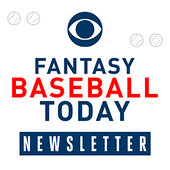
Fantasy Baseball Today Newsletter
Your Cheat Code To Fantasy Baseball
You're destined to gain an edge over your friends with advice from the award-winning FBT crew.
Thanks for signing up!
Keep an eye on your inbox.
Sorry!
There was an error processing your subscription.
Kodai Senga
I'm genuinely surprised there isn't more hype around Senga. He's not a prospect in the classic sense, and his profile from Japan suggests control and innings could be limitations on his upside. But we've also seen this dude pitch and it's pretty exciting! He pitched in front of the Statcast cameras earlier this week and averaged 95.3 mph with his fastball and had four whiffs on 13 sliders (technically "sweepers"). He's barely used his signature pitch, that fabled "ghost fork" in the spring, either, so I'm less concerned about the results we've seen. He's a top-150 pick for me.
Josiah Gray
Gray has one glaring flaw in his game: His fastball is bad. He throws it hard, but without much spin or movement, and at an angle that tends to generate a ton of hard-hit fly balls. He threw it just 39.2% of the time last season, but he still gave up 24 homers with the pitch, a horrific number. His slider and curveball are both excellent pitches, but unless Gray can limit the damage on the heater, it won't matter. When a player has a glaring flaw, the first thing you want to see from them in a new season is some self-awareness about that flaw, and Gray sure seems aware of it. In his most recent start of the spring, Gray threw his fastball just 26% of the time, substituting a cutter as his primary pitch. I have no idea if the cutter is going to solve all of Gray's issues, but given how good his secondary pitches already are, I'm intrigued by the tweak. Gray had to do something to take a step forward, and he's done something. That's enough to keep him squarely in the late-round discussion for me.
Hayden Wesneski
Despite his very strong late-season cameo in 2022, Wesneski really wasn't even on my late-round radar coming into the spring. I just didn't see much in his profile to suggest he had the stuff to matter for Fantasy. However, after averaging 93.1 mph with his fastball and maxing out at 95.9 last season, he has seemingly taken a leap this offseason. He touched 97 in his most recent spring outing and told reporters it isn't the hardest he's thrown, hinting that he's hit 99 at points this spring. Wesneski's sweeper is a legitimate out pitch, and if the rest of the profile catches up, Wesneski suddenly looks a lot more interesting.
Ben Joyce
If you follow any pitching-centric Twitter accounts, you're probably aware of Joyce and his 105.5 mph fastball. He was a third-round pick by the Angels in last year's draft despite a relief-only profile and a lengthy injury history, and both of those factors make it likely he'll be fast-tracked to the majors. As does the fact that the Angels have playoff aspirations and a bunch of late-inning options who could be most charitably described as "iffy." Joyce likely won't open the season as the team's closer, but I wouldn't be surprised if he gets an opportunity fairly quickly and locks down the job. In deeper leagues, he's someone I'm going to make sure I stash late.













